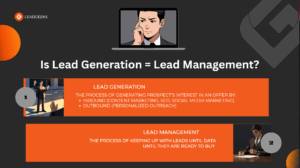In the realm of B2B marketing, distinguishing between lead generation and lead management is crucial for companies aiming for growth. Each serves a unique purpose in cultivating high-quality leads, and understanding their roles can profoundly impact business outcomes. In this post, we will be covering differences and how you can make them work for you and your business.
Lead Generation
Think of lead generation as your way to wave hello to potential clients. It’s about grabbing attention and making them curious about what you have to offer. Before we jump into how you can attract these potential clients, it is important that you are targeting the right audience.
Not all leads are equal. In order to succeed, you need to prepare an outline of what your business consider as an Ideal Customer Profile (ICP); targets in your audience who will likely be interested in your product or services. While it is possible for anyone to generate a list of contacts through the use of data brokers or online searches, this can result in leads that do not perform. Researching and narrowing down your targets through the use of an ICP will allow you to not only make you better understand your audience, but also make your lead generation more effective as you spend less time with bad leads.
Here’s How:
- Content Marketing: Share content relevant to your audience pain points.
- SEO and SEM: Make sure your content shows up in search engines and easy to find.
- Social Media: Find the community your audience frequent and engage them there.
- Personalized Outreach: Send them relevant content that speaks to them and their needs.
Lead Management, the Difference
Once you’ve generated enough leads and got their attention, an effective lead management allows you to keep the conversation going. While it’s part of the process, it’s not as simple as listing contacts that have already been contacted and when you’re going to contact them next time.
An effective lead management process not only effectively keep track of potential clients, but also effective nurturing in leading them to becoming paying customers. This process includes keeping track of leads’ intent data and conversation and nurturing them with content they want to see at the right time.
Here’s How:
- CRM Systems: Essential for keeping track of lead interactions and progress.
- Email Marketing: Keep in touch with leads by offering valuable content through emails.
- Lead Scoring: Identify which leads are most likely to convert based on how close they are to your ICP, allowing you to prioritize effectively.
Combining Lead Generation and Management
For the best results, lead generation and lead management must work together:
- Seamless Integration: Link your lead generation tools with your CRM to ensure none of your leads slip through the cracks.
- Consistent Communication: Maintain clear and consistent approach to your outreach from your first interaction to the last, building trust along the way.
- Iterative Improvement: Use insights from both lead generation and management to refine your approach continually.
Mastering both lead generation and lead management is more than just acquiring leads—it’s about creating meaningful connections that facilitate the transition from lead to customer. By engaging your target audience strategically and nurturing these relationships, you can set your B2B business up for long-term success.
Like what you read in this post? Explore more in our blog here!
















Leave a Reply